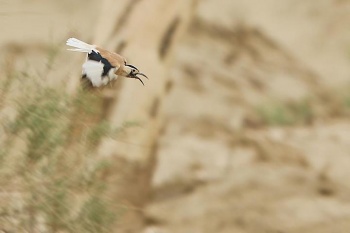Alternative names: Biddulph's Ground-Jay; Sinkiang Ground-Jay; Tarim Ground-Jay; White-tailed Ground-Jay; Biddulph's Ground-Chough
- Podoces biddulphi
Identification
26·7–31·2 cm (10½-12¼ in). A distinctive corvid:
- Glossy black crown and nape
- Lores and rest of head pale sandy
- Blackish chin, upper throat and malar area
- Sandy brown upperparts, darker brown on scapulars, rump and uppertail-coverts
- Black and white wings
- Pinkish sandy buff underparts
- White tail
- Dark brown eye
- Black, gently decurved bill
- Black legs
Sexes similar. Juveniles have diffuse dusky markings on tail and the wings are dull black, not glossy.
Similar species
Similar to Mongolian Ground-Jay but note white tail and black on throat.
Distribution
Endemic to the Taklimakan Desert in Xinjiang, China.
A restricted-range species with a serious population decline in the last decades.
Taxonomy
This is a monotypic species[1].
Forms a species pair with Mongolian Ground-Jay and is sometimes included with the latter in the genus Eupodoces.
Habitat
Sandy desert, scrub and desert poplar between 900 and 1200m.
Behaviour
Diet
Feeds omnivorous on seeds, grain and insects.
Usually seen in pairs or families of up to 6 birds. May be seen in human settlements.
Breeding
Breeding season starts in late March. The nest is a bowl made of twigs and rootlets. It's placed low in a bush, rarely on ground. Lays 1 - 3 eggs.
Movements
A resident species.
Gallery
Click on photo for larger image
Photo by James Eaton
Taklimakan Desert, Tibet
References
- Clements, J. F., T. S. Schulenberg, M. J. Iliff, D. Roberson, T. A. Fredericks, B. L. Sullivan, and C. L. Wood. 2016. The eBird/Clements checklist of birds of the world: v2016, with updates to August 2016. Downloaded from http://www.birds.cornell.edu/clementschecklist/download/
- Del Hoyo, J, A Elliott, and D Christie, eds. 2009. Handbook of the Birds of the World. Volume 14: Bush-shrikes to Old World Sparrows. Barcelona: Lynx Edicions. ISBN 978-8496553507
Recommended Citation
- BirdForum Opus contributors. (2024) Xinjiang Ground Jay. In: BirdForum, the forum for wild birds and birding. Retrieved 18 April 2024 from https://www.birdforum.net/opus/Xinjiang_Ground_Jay






